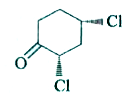Which of the following MO's have two nodal plane ? .
σ2pz
π∗2px
π∗2py
σ∗2pz
The correct Answer is:A, B, C
To determine which molecular orbitals (MOs) have two nodal planes, we need to understand the concept of nodal planes in molecular orbital theory. A nodal plane is a region in a molecular orbital where the probability of finding an electron is zero.
1. Understanding Nodal Planes:
- A nodal plane is defined as a plane where the electron probability density is zero. In molecular orbitals, the number of nodal planes is related to the shape and type of the orbital.
2. Identifying Molecular Orbitals:
- We need to analyze the given molecular orbitals. The common types of molecular orbitals are σ (sigma), π (pi), and their corresponding antibonding orbitals (σ* and π*).
3. Analyzing π and π* Orbitals:
- For π (pi) molecular orbitals, which result from the lateral overlap of p-orbitals (e.g., p_x and p_y), we can observe that:
- The bonding π orbital has one nodal plane.
- The antibonding π* orbital has two nodal planes.
4. Conclusion:
- Therefore, the π* molecular orbital (specifically the antibonding π orbital) will have two nodal planes. This is because the antibonding nature introduces additional nodes compared to the bonding orbital.
5. Final Answer:
- The molecular orbital that has two nodal planes is the π* (pi star) orbital.
- A nodal plane is defined as a plane where the electron probability density is zero. In molecular orbitals, the number of nodal planes is related to the shape and type of the orbital.
- We need to analyze the given molecular orbitals. The common types of molecular orbitals are σ (sigma), π (pi), and their corresponding antibonding orbitals (σ* and π*).
- For π (pi) molecular orbitals, which result from the lateral overlap of p-orbitals (e.g., p_x and p_y), we can observe that:
- The bonding π orbital has one nodal plane.
- The antibonding π* orbital has two nodal planes.
- Therefore, the π* molecular orbital (specifically the antibonding π orbital) will have two nodal planes. This is because the antibonding nature introduces additional nodes compared to the bonding orbital.
- The molecular orbital that has two nodal planes is the π* (pi star) orbital.
Topper's Solved these Questions
- CHEMICAL BONDING AND MOLECULAR STRUCTUREBook:CENGAGE CHEMISTRY ENGLISHChapter:CHEMICAL BONDING AND MOLECULAR STRUCTUREExercise:Exercises Multiple Correct (Miscellaneous)
Explore 10 Videos
- CHEMICAL BONDING AND MOLECULAR STRUCTUREBook:CENGAGE CHEMISTRY ENGLISHChapter:CHEMICAL BONDING AND MOLECULAR STRUCTUREExercise:Exercises Single Correct (Chemical Bonding)
Explore 46 Videos
- CHEMICAL BONDING AND MOLECULAR STRUCTUREBook:CENGAGE CHEMISTRY ENGLISHChapter:CHEMICAL BONDING AND MOLECULAR STRUCTUREExercise:Exercises Multiple Correct(Bond Angle )
Explore 5 Videos
- ATOMIC STRUCTUREBook:CENGAGE CHEMISTRY ENGLISHChapter:ATOMIC STRUCTUREExercise:Concept Applicationexercise(4.3)
Explore 19 Videos
- CHEMICAL EQUILIBRIUMBook:CENGAGE CHEMISTRY ENGLISHChapter:CHEMICAL EQUILIBRIUMExercise:Subjective type
Explore 1 Video
Similar Questions
Knowledge Check
Which of the following compounds have the plane of symmetry?
A B
B C
C D
D
Which of the following compounds do not have the plane of symmetry?
A B
B C
C D
D
Which of the following has/have zero average value in a plane electromagnetic wave?
ABoth magnetic and electric fieldsBElectric field onlyCMagnetic field onlyDNone of these
Which of the following MOs has more than one nodal plane?
View SolutionIn which of the following set of orbitals, nodal plane is absent ?
View SolutionAccording to the moleular orbital theory, all atomic orbitals combine to form molecular orbital by LCAO (linear combination of atomic orbitals) method When two atomic orbitals have additive (constructive) method When two atomic orbitals have additive (constructive) overlapping they form bonding molecular orbitals (BMO) which have lower energy than atomic orbitals whereas when atomic orbitals overlap subtractive higher energy antibonding molecular orbitals (ABMO) are formed Each MO occupies two electrons with opposite spin Distribution of electrons in MO follows Aufbau principle as well as Hund's rule MO theory can successfully explain the magnetic behaviour of molecules
Which of the following is/are not paramagnetic ? .
View SolutionWhich one of the following has maximum number of nodal planes ? .
View SolutionWhich of the following have zero average value in a plane electromagnetic wave?
View Solution